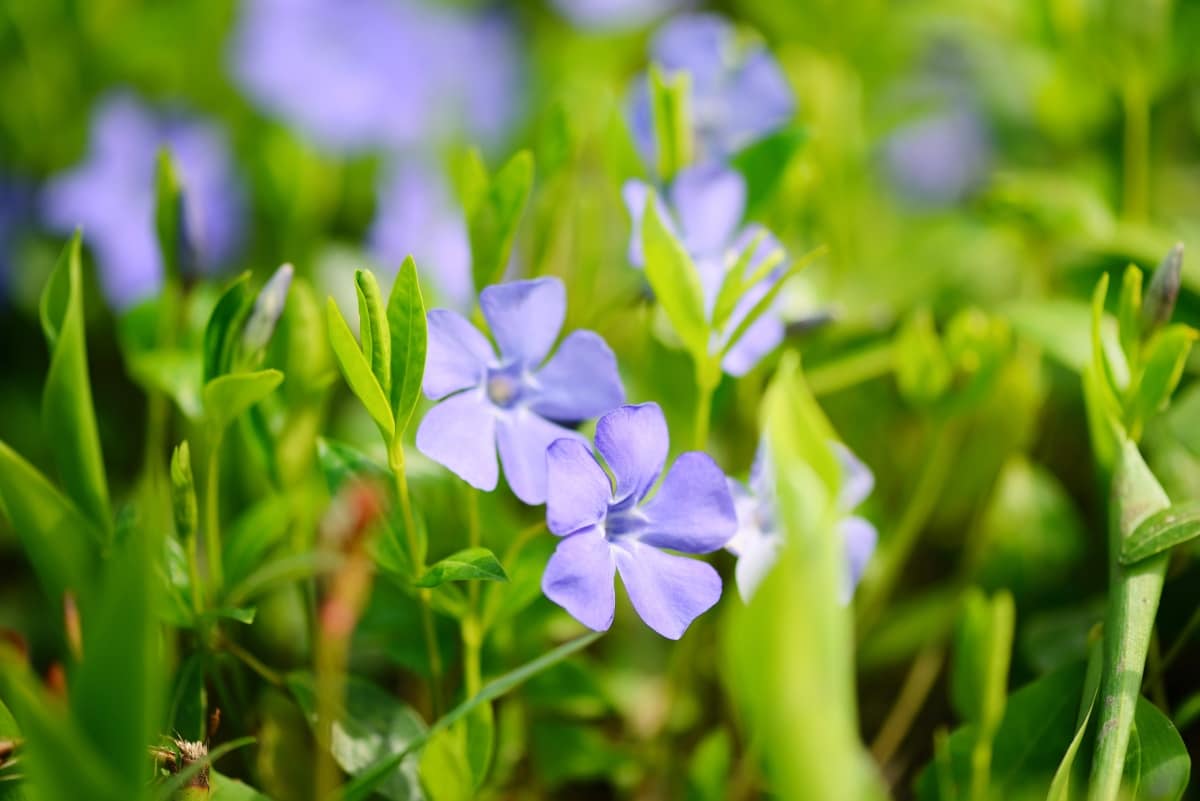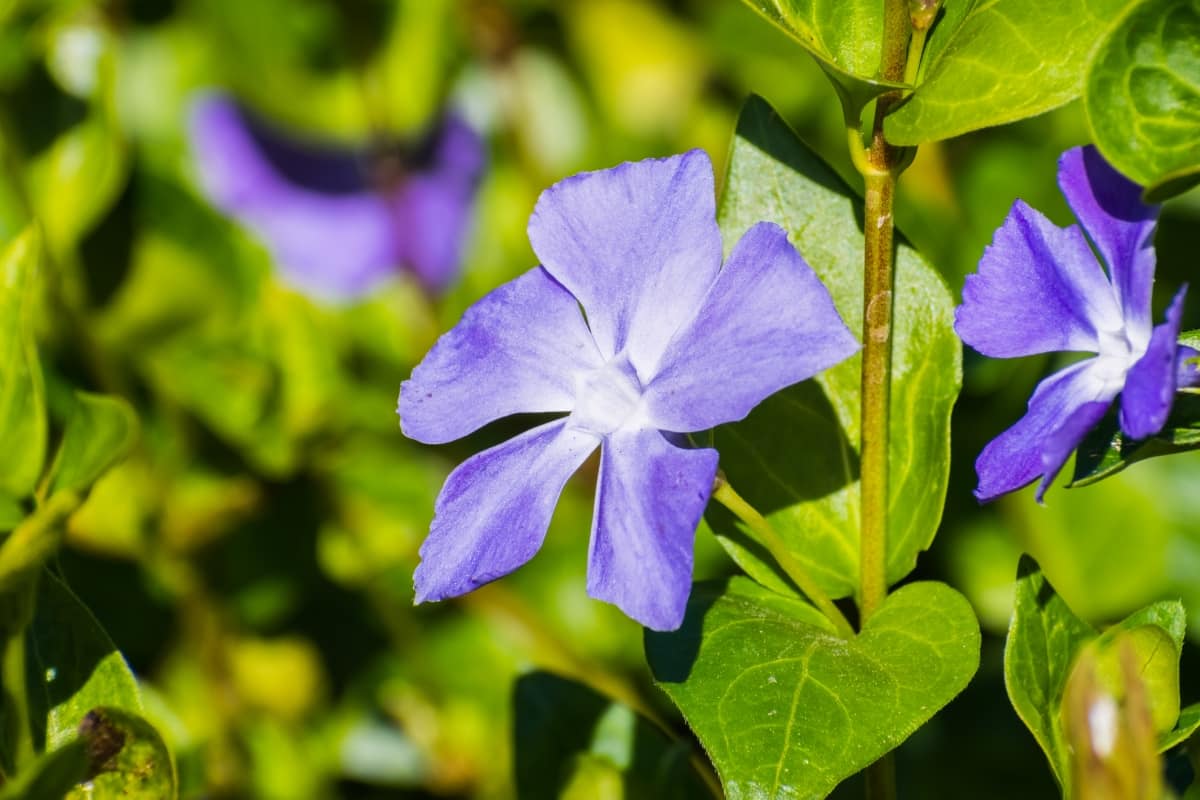The scientific name of the Periwinkle flower is Catharanthus roseus, belonging to the Apocynaceae family. Periwinkle plants can face various issues that affect their health and appearance. Periwinkle is a beautiful and low-maintenance plant that can encounter several leaf and flower-related problems.

Yellowing of Leaves
Yellowing Periwinkle leaves can be a sign of overwatering or poor drainage. Ensure that your Periwinkle plants are in well-draining soil to prevent waterlogged roots. Another possible cause of yellowing leaves is nutrient deficiency. Consider feeding your plants with a balanced fertilizer to provide them with the necessary nutrients for healthy growth. Regularly inspect the undersides of the plant leaves for any unwanted visitors that may be affecting the health of your Periwinkles.
Leaf Spot Diseases
Periwinkle plants are a beautiful addition to any garden, but they can be susceptible to leaf spot diseases. These plant diseases are caused by fungi and bacteria that thrive in moist conditions. If you notice black or brown spots on the leaves of your Periwinkle plant, it may be suffering from leaf spot disease.
Leaf spot diseases can weaken the plant and make it more susceptible to other issues like root rot. To combat these pesky diseases, try removing any infected plant leaves and improving air circulation around the plant. Remember always to follow instructions carefully when using chemical treatments on your plants.
Powdery Mildew
Powdery mildew, a common issue that can plague Periwinkle plants, appears as white powdery spots on the leaves and stems. This fungal disease thrives in humid conditions with poor air circulation. It not only affects the aesthetics of the plant but also weakens it over time if left untreated.
To combat powdery mildew naturally, you can try spraying a water and baking soda mixture on the affected areas. Additionally, neem oil or horticultural oils may also help suppress the spread of this pesky fungus. Properly spacing out your plants to improve airflow can prevent powdery mildew from recurring in the future. Regularly inspecting your Periwinkle plants for any signs of powdery mildew is key to catching and addressing it early on.
Rust
Rust on Periwinkle leaves and flowers can be a frustrating sight for any gardener. It appears as orange or brown spots, giving the plant a weathered look. This fungal disease thrives in humid conditions, spreading rapidly if left unchecked. To combat rust on your Periwinkle plants, start by removing and disposing of infected leaves to prevent further spread.
In case you missed it: How to Grow and Care for Periwinkle Flowers: A Step-by-Step Guide

Consider using organic fungicides like neem oil or copper-based sprays to help control rust outbreaks. Regularly inspect your Periwinkle plants for any signs of new infections and take prompt action to protect your beloved Periwinkles from this pesky problem.
Aphid Infestation
Aphids are those pesky little insects that can wreak havoc on your Periwinkle plants. These tiny pests love to suck the sap from the plant leaves and stems, causing them to curl up and wilt. You can notice a sticky substance called honeydew left behind by aphids, which can attract ants.
To tackle an aphid infestation naturally, try spraying your Periwinkle plants with a mixture of water and dish soap. This solution will help suffocate the aphids without harming your beloved Periwinkles. Ladybugs are also beneficial predators that feed on aphids and keep their population in check. Regularly inspecting your plants for signs of aphids is key to catching an infestation early.
Spider Mites
Spider mites thrive in dry conditions, making them a common nuisance for indoor and outdoor plants alike. If left unchecked, these pesky critters can cause significant harm to your Periwinkle’s foliage, leading to yellowing or speckled leaves. To combat spider mite infestations naturally, consider introducing predatory insects like ladybugs or using organic insecticidal soaps.
In case you missed it: How to Fix Zinnias Leaf and Flower Problems: Discover Natural and Home Remedies

Regularly spraying your Periwinkle plants with a strong stream of water can also help dislodge these tiny pests before they cause widespread damage. Keep a close eye on your Periwinkles for any signs of spider mite activity, and take action to protect your beautiful blooms from these troublesome invaders.
Botrytis Blight
This fungal disease can quickly spread in damp conditions, causing greyish-brown spots on leaves and flowers. Botrytis Blight thrives in humid environments, so proper air circulation is key to preventing its spread. Make sure to water your Periwinkles at the plant base to avoid wetting the foliage, as moisture on plant leaves can promote the growth of this fungal infection.
To combat Botrytis Blight, remove any affected plant parts immediately and dispose of them properly. Consider applying organic fungicides or natural remedies like neem oil to help control the spread of Botrytis Blight and protect your precious Periwinkle blooms from further damage.
Root Rot
Root rot is a major issue that can affect Periwinkle plants, causing damage to the roots and ultimately impacting their overall health. This fungal disease thrives in overly moist soil conditions, leading to root decay and decreased nutrient absorption. Symptoms of root rot include yellowing leaves, wilting foliage, and stunted growth. To prevent this problem, it is crucial to ensure proper drainage by planting Periwinkles in well-draining soil and avoiding overwatering. Remove affected areas carefully using sterilized tools and replant in fresh soil if necessary.
Fungal Wilts
These fungal diseases can affect the roots of your plants, causing them to wilt and eventually die. Fungal wilts are often caused by soil-borne pathogens that infect the plant’s vascular system, disrupting the flow of water and nutrients. As a result, the leaves may start to yellow, wilt, or even drop off entirely. Good sanitation measures are essential to prevent fungal wilts from spreading in your garden. Consider using natural remedies like neem oil to help combat fungal wilts in your Periwinkle plants.
In case you missed it: How to Propagate Pothos from Leaf Cuttings, Stem Cuttings in Water and the Soil

Snail and Slug Damage
Snails and slugs can cause damage to Periwinkle plants by feeding on their leaves and flowers. These pests are particularly attracted to the tender foliage of Periwinkles, leaving behind a trail of destruction in their wake. Snails and slugs love to feast on tender Periwinkle leaves, leaving behind unsightly holes and damage. To prevent snail and slug damage, consider using natural remedies such as diatomaceous earth around your plants to make a barrier that these pests will avoid crossing.
Periwinkle plants are beautiful additions to any garden with their vibrant flowers and glossy leaves. It is a popular choice for home gardeners due to its ability to thrive in various conditions. Additionally, selecting disease-resistant varieties can help minimize the occurrence of leaf and flower-related problems.
- Flower Garden Designs and Layouts for Beginners
- Planting and Spacing Techniques in Papaya: A Beginner’s Guide
- Growing Gold: Essential Techniques for Planting Pineapples
- How to Make Kalanchoe Plant Bushy: Home Remedies and Solutions
- 11 Reasons Why Your Gardenia is Not Blooming: Home Remedies and Solutions
- Eco Elegance: The Guide to Designing a Drought-Tolerant Landscape
- Gardening on a Slope: Strategies for Hillside Landscaping
- Nourish and Flourish: Top Organic Mulches for Thriving House Plants
- Everything You Want to Know about Indian Mogra Flower: Discover Uses and Growing